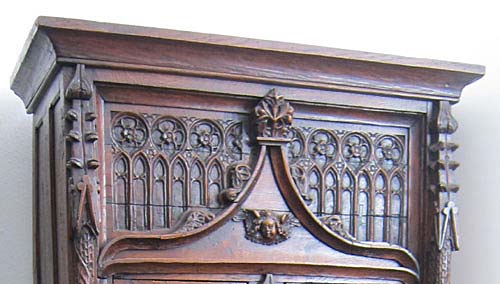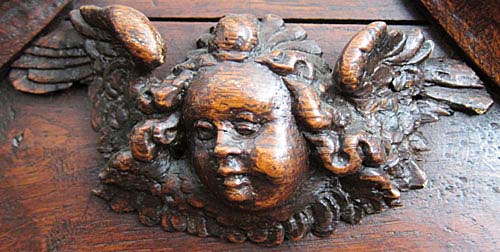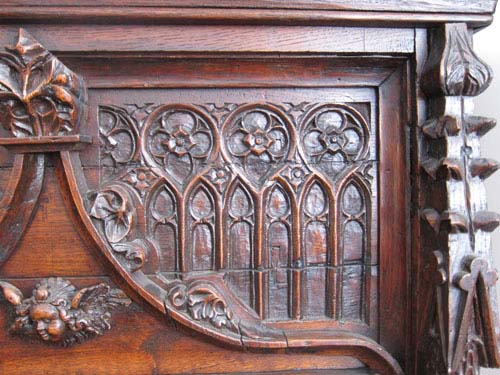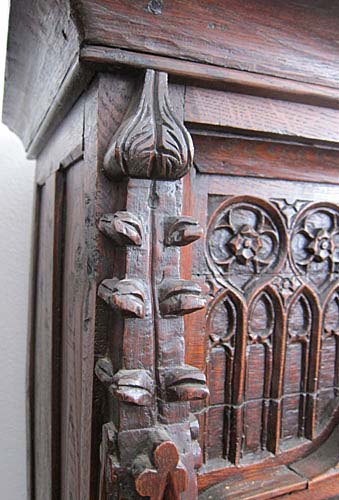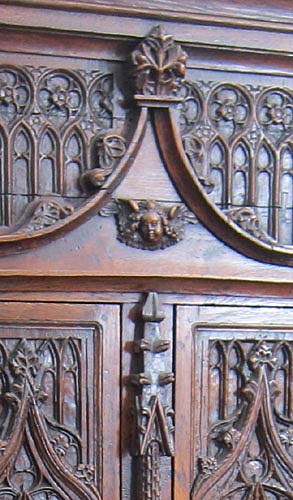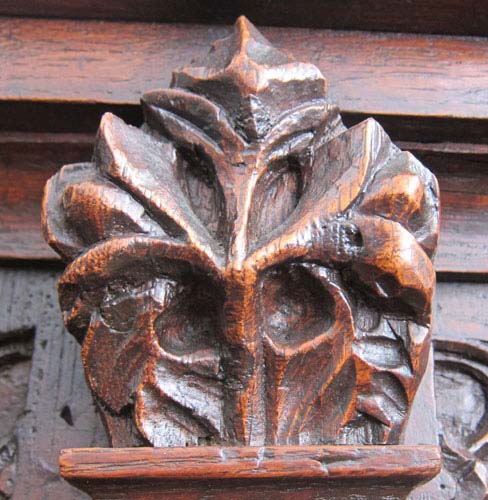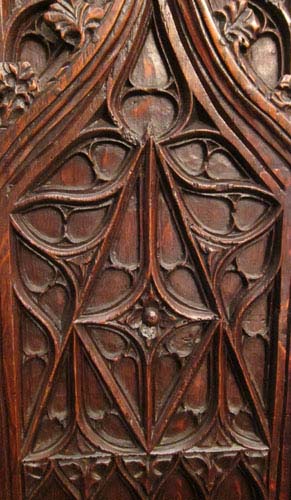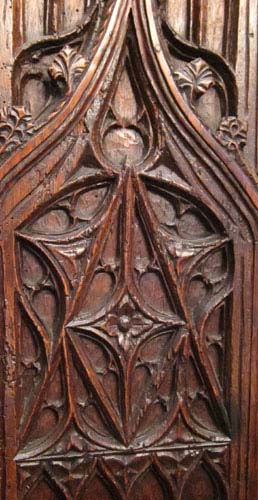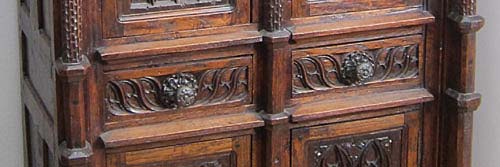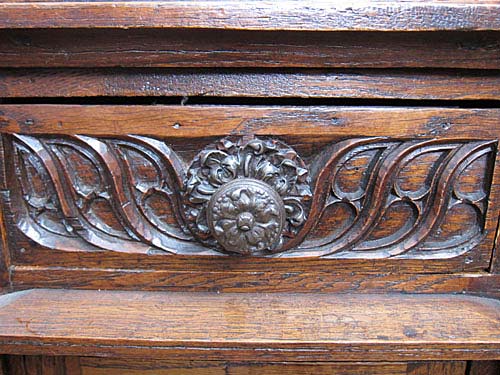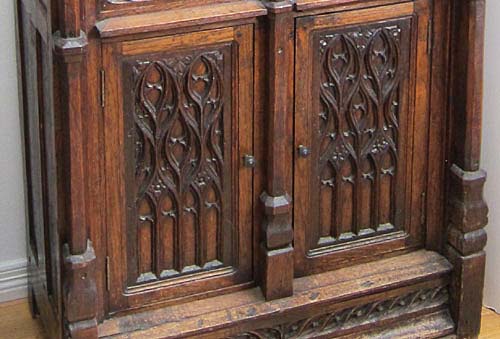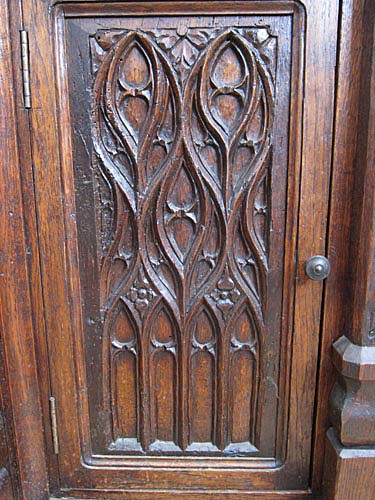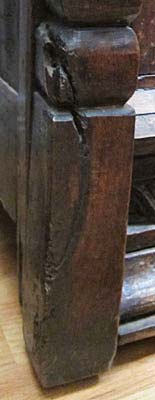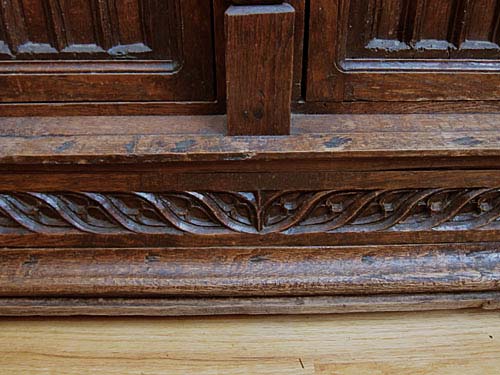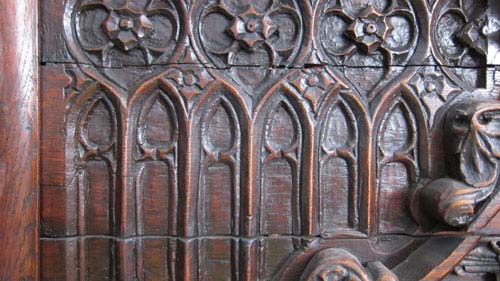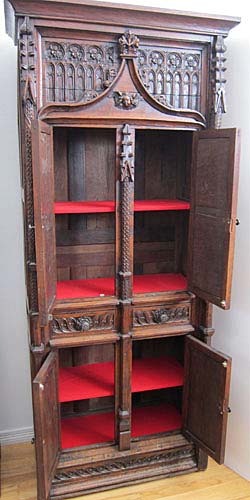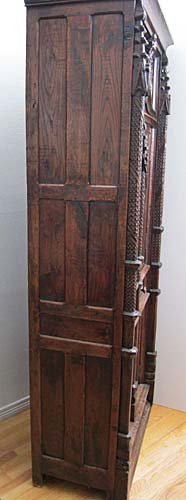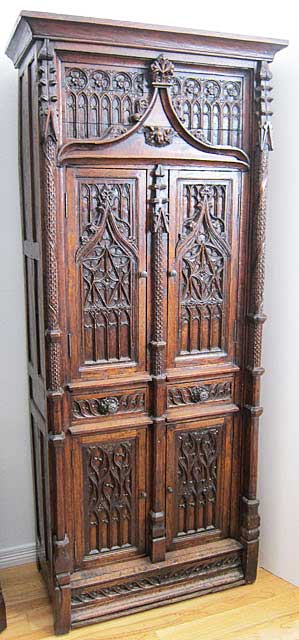
For fans of Gothic design elements such as fenestrage (tracery) and spires, this armoire is a feast for the eyes. Made from solid oak, the hand carving is magnificent and more finely detailed than one would think possible for this hardwood transformed into furniture. It beckons the viewer to feel the finials, trace the tracery, and ogle the ogives while marveling at the mastery of its unnamed creator whose distinctive handwork is revealed on closest examination.
In overall structure, we have called this an armoire because of its height but it is also a cabinet because, unlike the typical armoire, the doors do not run the full length of the piece. Regardless of classification, it can be viewed as an ogive arch encased within a rectangle framed by pilasters whose tops are crocketed finials.
The crocketing on the gently sloping sides of the central arch is especially rich in its carving, evoking the curled acanthus leaves that such ornaments were deigned to mimic but that later became stylized bumps more like those on the finials. At the culmination of the arch, resting on its own tiny shelf is a large leaf, possibly an oak leaf to symbolize the tree from which this cabinet is carved. On either side of the ogive are lancet arches supporting quatrefoils, with the empty spaces between them packed by tiny floral motifs.
Within the ogive is a space devoid of ornamentation except for an angelot or cherub - an angel's head with wings attached. Instead of looking straight out at the viewer, as on other pieces we have had in our collection, this angelot's gaze is downward and to its right. We can only speculate, but this may have been added later, having something to do with the location for which the cabinet was made? Perhaps a painting or statute was meant to be the focus of the room and the angel's stare. In any event, the details of the hair and wings are masterfully rendered, causing the eye to examine the angelot closely and then to follow its gaze.
The part of the cabinet below the central arch is comprised of two doors. At first glance, they appear to be identical but for the placement of the knobs on the right or left side. Those knobs are uninteresting and appear to be replacements employing a magnetic closure.
On closer examination, the creator has fooled us and while the doors are clearly based on the same design, there are distinctions. Perhaps this relates back to the medieval notion that no two things could ever be identical because only God could make a perfect copy? Both door panels employ identical central compositions based on an isosceles triangle. At the halfway point of the sides of the triangle, straight lines emerge and meet at the base, forming a diamond shape within the larger triangle and two smaller triangles on either side. Such a design based on angles, and specifically triangles, is very unusual for fenestrage or tracery where curved shapes abound, including the mouchettes (curved shapes tapering into points) that fill the spaces within the triangles.
As in the uppermost part of the armoire, the door panels include an overall ogive design. Where the two door panels depart in design is the right panel's incorporation of an additional arch within the ogive while the left panel simply incorporates two additional mouchettes to fill the frame.
Mouchettes form the repeating decorative element on the two drawers that act like a belt to separate upper and lower portions of the armoire. Each drawer has a decorative knob based on a flower, reflecting the intricately carved circular frame within which it is mounted.
The lower part of the armoire includes two doors, this time identical (challenging medieval superstitions), and based on lancet arches from which the tracery seems to rise in alternating patterns of mouchettes. Below this is the base moulding, also reflecting a repeating design of mouchettes evoking that of the drawers.
That this is a piece meant to be viewed and appreciated head-on is evidenced by the lack of ornamentation on the sides. Simple, rectangular insets are arranged to mirror the zones found on the front. In their simplicity they invite appreciation of the wood itself and its luscious patina, fully apparent in the absence of ornamentation.
The photos reflect some cracking in the fenestrage, which we attribute to age and the possibility that it may be older than the date attributed to it. There has also been a repair to the left front foot, shown in the photo below. As the penultimate photo reflects, some previous owner has thoughtfully finished the entire interior in red felt. We have not removed it, as we think it lends an unexpected aura to a piece whose details merit close examination and appreciation.
Please note that the difficulty of photographing items of this size can result in color variations. We believe that the truest representation of the color of this armoire is in the photograph at the top of this page.
Reference
Boccador, Jacqueline, Le Mobilier Français du Moyen Age à la Renaissance (Editions d'Art Monelle Hayot, Saint-Just-en-Chaussée, 1988); Thirion, Jacques, Le Mobilier du Moyen Age et de la Renaissance en France (Editions Faton, Dijon, 1998); Viollet-le-Duc, Eugène, Le Mobilier Médiéval (Georges Bernage, editor) (Editions Heimdal, 2003) .
Uses
This armoire or cabinet would work well in virtually any room, from kitchen to dining room, library to office, with oodles of storage space.
